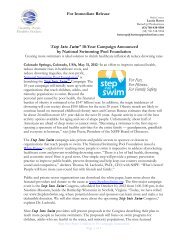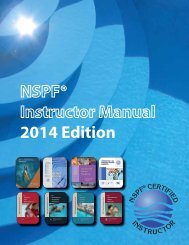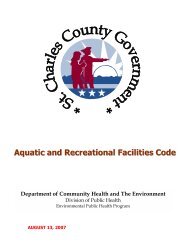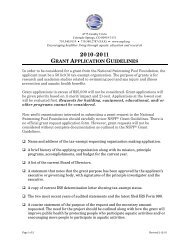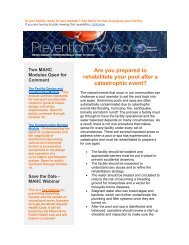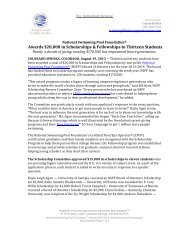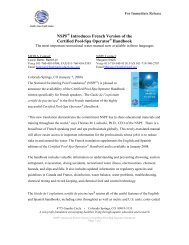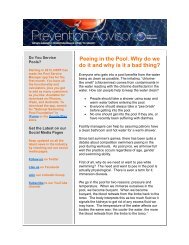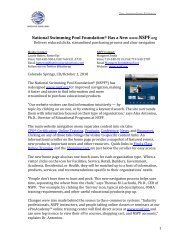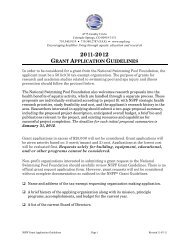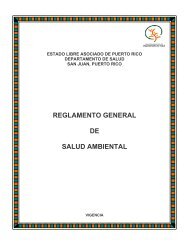English Instructor Manual (PDF) - Metric Version - National ...
English Instructor Manual (PDF) - Metric Version - National ...
English Instructor Manual (PDF) - Metric Version - National ...
You also want an ePaper? Increase the reach of your titles
YUMPU automatically turns print PDFs into web optimized ePapers that Google loves.
Key Points: Discuss the various aspects of total dissolved solids (TDS). These include:<br />
TDS is the measure of all minerals dissolved in water. TDS is easier to understand<br />
if it is renamed as “totally dissolved solids”. For example, sugar is a solid before it is<br />
dissolved in water. But once dissolved, it becomes “totally” dissolved and can no longer<br />
be observed in the water. However, if enough sugar is continuously dissolved, the water<br />
becomes saturated and will not dissolve anything else. This is called “old” water.<br />
Generally agreed that TDS should not become higher than 1,500 mg/L above its start up<br />
value.<br />
The only inexpensive way to reduce TDS is by draining or diluting the existing water with<br />
water with a lower TDS level.<br />
TDS levels up to 1,000 mg/L use a saturation index factor of -12.1 when calculating the<br />
Saturation Index. For TDS greater than 1,000 mg/L use -12.2.<br />
Key Points: Discuss that the Langelier saturation index is a method to measure if water is<br />
balanced. Explain that it is not the only method, but that it is the most commonly used method in<br />
the pool industry.<br />
Using the Langelier Saturation Index handout, explain how to use the formula for<br />
calculating saturation index. Explain how to use the charts for converting measured<br />
values for total alkalinity, calcium hardness, and temperature into factors that can be<br />
used in the formula.<br />
Explain that when all the factors are calculated, the following values can be used to<br />
determine if the water is corrosive, scale-forming, or balanced:<br />
The ideal range for balanced water is between -0.3 to +0.3.<br />
Activity: Using the Langelier Saturation Index handout, the Saturation Index Worksheet, and the<br />
Water Quality Guidelines handout, do several saturation index calculations. Provide students with<br />
blank copies of the Saturation Index Worksheet to use for this lesson and to have for the fi nal<br />
exam.<br />
Explain that when making corrections for unbalanced water, follow these rules:<br />
All the values must be in the ideal range. For example, if the pH is 7.9 in the original<br />
calculation, it must be changed to a value between 7.4-7.6 when making corrections to<br />
balance the water.<br />
The SI value must be in the ideal range (-0.3 to +0.3). Even though all the water<br />
balance elements may have values in the ideal range, the SI may not be ideal. If this is<br />
the case, changes should be made to the saturation index values for pH, total alkalinity,<br />
and calcium hardness so that the SI falls within the ideal range.<br />
Key Points: Explain that the difference between the original measured values and the theoretical<br />
values that the participants have used to balance the water is called the adjustment. For example,<br />
if the total alkalinity was 50 mg/L in the original calculation and was changed to 80 mg/L to<br />
balance the water, the adjustment for total alkalinity is 30 mg/L (80 - 50 = 30). To balance this<br />
water in reality, an amount of chemical that will increase the total alkalinity by 30 mg/L will have to<br />
be added to the water. That calculation will be explained later.<br />
Key Points: Discuss the adjustment order. Typically, the alkalinity should be adjusted before pH.<br />
If calcium hardness needs to be lowered, do that before making other adjustments since the water<br />
will need to be changed or diluted.<br />
© 2014 <strong>National</strong> Swimming Pool Foundation® Page 59



